
EV Owners Replacing Tires Twice as Often
I remember when the first Teslas came out, early adopters I knew hoped EV tires would last much longer than on regular cars. They told me Teslas had a cutting edge slip limiting system that applied as much power as possible without spinning the tires.
This sounded like good news all around: not only are tires expensive, but producing and disposing of them is not great for the environment. Unfortunately, the truth is just the opposite. EV drivers are reporting they are replacing their tires at twice the rate of traditional gasoline vehicles.

Here are the details: Every year, J.D. Power interviews owners of three-year-old cars about problems, glitches, and repairs thus far. This year’s findings:
BEV owners had to replace their tires during the third year of ownership at nearly twice the rate of gas-powered vehicles—39 percent to 20 percent. That may be attributable to EVs being heavier than their gas-powered counterparts.
J.D. Power’s 2024 Dependability study
I know what you are asking: Are all those combustion car owners replacing their tires on year four? Nope. According to Nerd Wallet, the average set of new tires is lasting six years.
It is true that the weight of lithium ion batteries make EVs 30% heavier than comparable gas-powered vehicles, on average. But the weight difference grows with the size of the vehicle: the less efficient an EV the bigger its battery pack must be for competitive range. So the Hummer EV weighs 9,000 pounds, with a 2,800-pound battery pack. But the lightest Tesla Model 3 comes in at 3,800 pounds. That’s less than some BMW 4 Series sedans.
I would wager that vehicle weight is only half of the issue. Two other unique features of EVs almost certainly contribute. The first is that electric motors make maximum torque at zero rpm. So even with cutting-edge traction control systems, starting from a standstill beats up tires. The second is regenerative braking. As EVs slow down, they turn those motors into generators and use the powertrain to slow the vehicle. This converts the car’s forward momentum back into battery charge. But this, again, subjects the tires to a bunch of torque and beats them up.
Here’s to hoping future generations of EVs will address these issues. Perhaps EV-specific tires will become better at handling this torque–both while starting out and while braking. And I’m sure EV engineers will develop better systems for balancing performance, efficiency, and tire wear. Perhaps the regen level could back off to save the tires when you are on your way to your home charger with plenty of juice left. Finally, automakers are pursuing battery chemistries with more energy density than lithium ion. When they come up with one, it will lighten EVs dramatically.
I’m going to yet again urge automakers to build lighter EVs–station wagon sized vehicles–that compensate for small battery packs with good kW/mile ratings and fast (800 volt) charging. I truly believe this is the best option for most drivers, with the technology currently available.
If you choose to buy one of the current EVs, budget to replace the tires early. If you really want to make them last, experiment with turning down regenerative braking and accelerating slowly.
Next, read about the problem of lithium hoarding, or watch an engineer explain the purpose-built EV tires:






